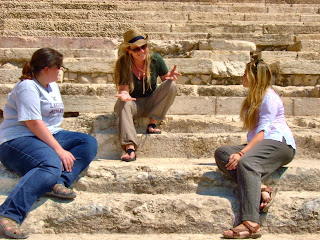Friday's with Focant and Mark's Gospel: Mark 1 (The Prologue: Part 1)
Moving to the commentary proper, and by way of disclaimer, I will not attempt a summarization of all that Focant says in his commentary, chapter-by-chapter, nor even section-by-section, but rather, I will point out some positions that the author takes that stood out to this reader.
Focant follows the majority of Markan scholars by insisting that the prologue comprises the first thirteen verses of the gospel (1:1-13). Considering that Mark 1:2 begins with the conflated citation of Isaiah 40:3, to illustrate the 'good news' (εὐαγγέλιον) of Mark 1:1, Focant writes:
As noted above, the quotation in Mark 1:2 is a "conflated" one (Exod 23:20; Mal 3:1; Isa 40:3) that Focant explains this way:In its beginning, the narrative gives up first place to the gospel that is attested in a Scripture much earlier. The narrative does not absorb the good news; it is rather absorbed in the good news that precedes it and that will continue after it in the mission of the disciples. On all sides, the gospel goes beyond, transcends the narrative written by Mark. Knowledge of this fact is registered in the way the book begins and ends (29).
Moving on to Mark 1:4-8, Focant observes that from an historical perspective the "all" of Judea and Jerusalem that come to John the Baptist in the wilderness is an exaggeration, but in the narrative, serves to illustrate "that his mission is accomplished: the way is ready..."(33). For the author, the 'stronger one' of 1:7 is Jesus as his is a baptism in the Holy Spirit, whereas the forerunner, John is one of water (1:8; 34). Focant also observes an interesting narrative connection, writing:The fact that he has placed the quotation under the patronage of Isaiah indicates the perspective from which it is appropriate to read it: a messenger is sent by God to prepare the way of Jesus, which will be the one of a new Exodus, God’s act of salvation (Marcus, Way, 12–47; Watts, Isaiah, 88–90), and it is obviously a matter of good news (29).
The next post will take a look at the remainder of the verses contained in the prologue (vv.9-13)At the level of the narrative as a whole, it is appropriate to once again raise the parallel between John, clothed in animal skins and sent “ahead” (pro) to “proclaim” (ekērussen) the one stronger than him, and the young man dressed in white, who at the conclusion will say that Jesus “goes before” (proagei) the disciples into Galilee (16:7) with the aim of launching the mission of “proclaiming” (kēruchthēnai) the gospel (13:10).



Comments